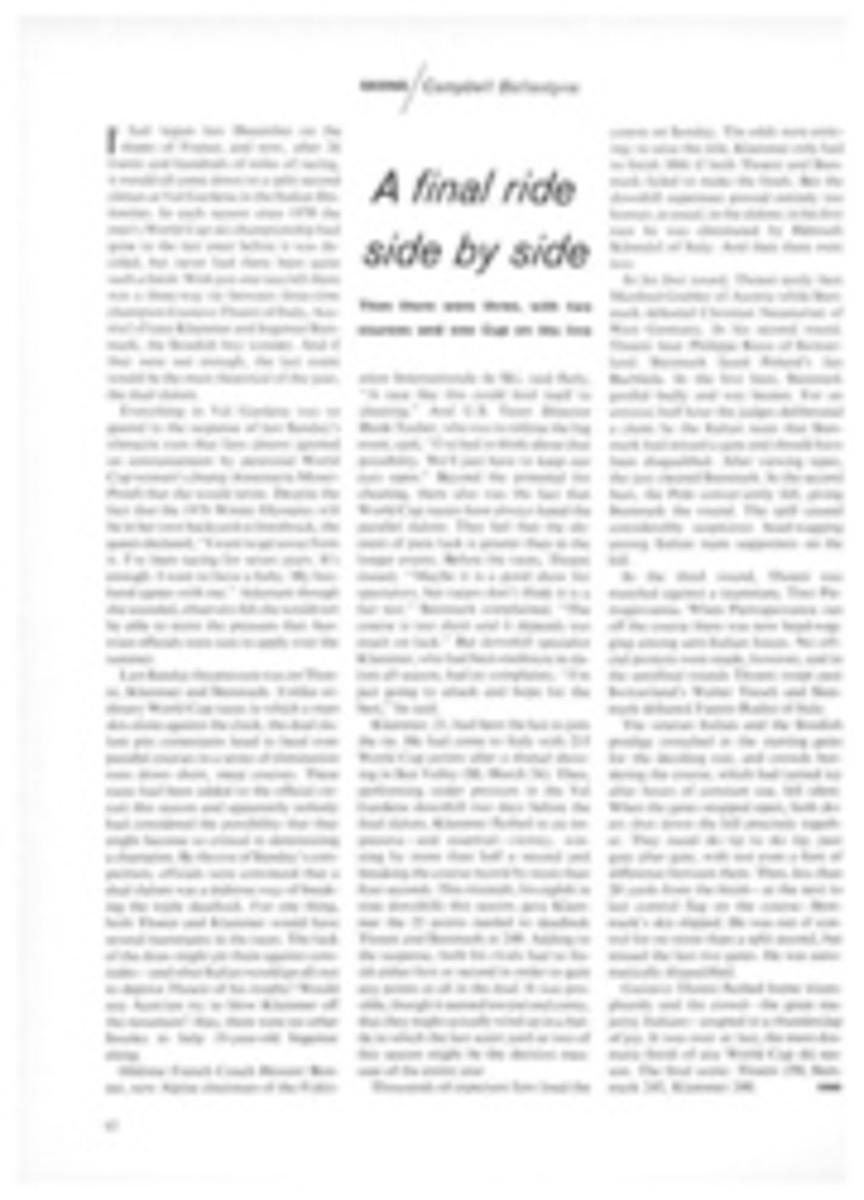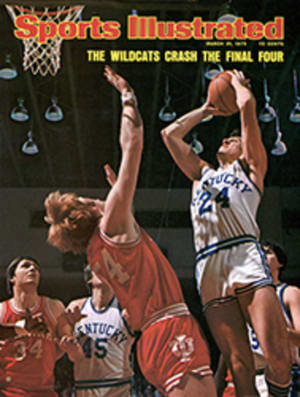
A final ride side by side
It had begun last December on the slopes of France, and now, after 26 events and hundreds of miles of racing, it would all come down to a split-second climax at Val Gardena in the Italian Dolomites. In each season since 1970 the men's World Cup ski championship had gone to the last meet before it was decided, but never had there been quite such a finish. With just one race left there was a three-way tie between three-time champion Gustavo Thoeni of Italy, Austria's Franz Klammer and Ingemar Stenmark, the Swedish boy wonder. And if that were not enough, the last event would be the most theatrical of the year, the dual slalom.
Everything in Val Gardena was so geared to the suspense of last Sunday's climactic runs that fans almost ignored an announcement by perennial World Cup women's champ Annemarie Moser-Proell that she would retire. Despite the fact that the 1976 Winter Olympics will be in her own backyard at Innsbruck, the queen declared, "I want to get away from it. I've been racing for seven years. It's enough. I want to have a baby. My husband agrees with me." Adamant though she sounded, observers felt she would not be able to resist the pressure that Austrian officials were sure to apply over the summer.
Last Sunday the pressure was on Thoeni, Klammer and Stenmark. Unlike ordinary World Cup races in which a man skis alone against the clock, the dual slalom pits contestants head to head over parallel courses in a series of elimination runs down short, steep courses. These races had been added to the official circuit this season and apparently nobody had considered the possibility that they might become so critical in determining a champion. By the eve of Sunday's competition, officials were convinced that a dual slalom was a dubious way of breaking the triple deadlock. For one thing, both Thoeni and Klammer would have several teammates in the races. The luck of the draw might pit them against comrades—and what Italian would go all-out to deprive Thoeni of his trophy? Would any Austrian try to blow Klammer off the mountain? Alas, there were no other Swedes to help 19-year-old Ingemar along.
Oldtime French Coach Honoré Bonnet, now Alpine chairman of the Fédération Internationale de Ski, said flatly, "A race like this could lend itself to cheating." And U.S. Team Director Hank Tauber, who was to referee the big event, said, "I've had to think about that possibility. We'll just have to keep our eyes open." Beyond the potential for cheating, there also was the fact that World Cup racers have always hated the parallel slalom. They feel that the element of pure luck is greater than in the longer events. Before the races, Thoeni mused, "Maybe it is a good show for spectators, but racers don't think it is a fair test." Stenmark complained, "The course is too short and it depends too much on luck." But downhill specialist Klammer, who had been mediocre in slalom all season, had no complaints. "I'm just going to attack and hope for the best," he said.
Klammer, 21, had been the last to join the tie. He had come to Italy with 215 World Cup points after a dismal showing in Sun Valley (SI, March 24). Then, performing under pressure in the Val Gardena downhill two days before the final slalom, Klammer flashed to an impressive—and essential—victory, winning by more than half a second and breaking the course record by more than four seconds. This triumph, his eighth in nine downhills this season, gave Klammer the 25 points needed to deadlock Thoeni and Stenmark at 240. Adding to the suspense, both his rivals had to finish either first or second in order to gain any points at all in the dual. It was possible, though it seemed too pat and corny, that they might actually wind up in a battle in which the last scant yard or two of this season might be the decisive measure of the entire year.
Thousands of expectant fans lined the course on Sunday. The odds were enticing: to seize the title, Klammer only had to finish 10th if both Thoeni and Stenmark failed to make the finals. But the downhill superman proved entirely too human, as usual, in the slalom; in his first race he was eliminated by Helmuth Schmalzl of Italy. And then there were two.
In his first round, Thoeni easily beat Manfred Grabler of Austria while Stenmark defeated Christian Neureuther of West Germany. In his second round, Thoeni beat Philippe Roux of Switzerland. Stenmark faced Poland's Jan Bachleda. In the first heat, Stenmark goofed badly and was beaten. For an anxious half hour the judges deliberated a claim by the Italian team that Stenmark had missed a gate and should have been disqualified. After viewing tapes, the jury cleared Stenmark. In the second heat, the Pole conveniently fell, giving Stenmark the round. The spill caused considerable suspicious head-wagging among Italian team supporters on the hill.
In the third round, Thoeni was matched against a teammate, Tino Pietrogiovanna. When Pietrogiovanna ran off the course there was now head-wagging among anti-Italian forces. No official protests were made, however, and in the semifinal rounds Thoeni swept past Switzerland's Walter Tresch and Stenmark defeated Fausto Radici of Italy.
The veteran Italian and the Swedish prodigy crouched in the starting gates for the deciding run, and crowds bordering the course, which had turned icy after hours of constant use, fell silent. When the gates snapped open, both skiers shot down the hill precisely together. They raced ski tip to ski tip, past gate after gate, with not even a foot of difference between them. Then, less than 20 yards from the finish—at the next to last control flag on the course—Stenmark's skis slipped. He was out of control for no more than a split second, but missed the last two gates. He was automatically disqualified.
Gustavo Thoeni flashed home triumphantly and the crowd—the great majority Italians—erupted in a thunderclap of joy. It was over at last, the most dramatic finish of any World Cup ski season. The final score: Thoeni 250, Stenmark 245, Klammer 240.

